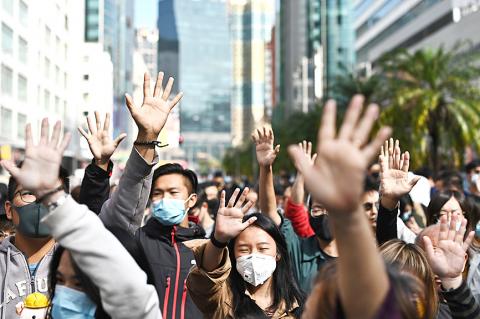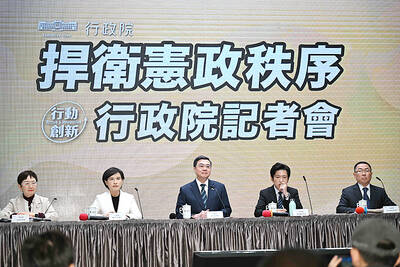Hong Kong police yesterday ended their blockade of the Hong Kong Polytechnic University campus after surrounding it for 12 days to try to arrest pro-democracy protesters holed up inside.
Police removed a stash of nearly 4,000 gasoline bombs left behind by protesters, who fought pitched battles about two weeks ago with riot officers on surrounding streets.
About 100 officers first entered the campus on Thursday to collect materials and remove dangerous items.

Photo: AFP
A police statement said that over two days, they seized 3,989 gasoline bombs, 1,339 explosive items, 601 bottles of corrosive liquids and 573 weapons.
No protesters were found.
One masked man told reporters that the night before police entered the campus about 20 people were still hiding to avoid arrest.
They were the holdouts from perhaps 1,100 people who had retreated inside after the battles with police.
A few escaped the cordon, but police said that they arrested 810 people and recorded the details of 300 minors who could later face charges.
Another 567 people were arrested in the vicinity of the university, police said.
A university official estimated that it would take five to six months to repair the damage to the campus.
During an official visit to Thailand, Hong Kong Chief Executive Carrie Lam (林鄭月娥) said that Hong Kong is undergoing a difficult period, but that the fundamentals of the territory, including its strengths under the “one country, two systems” framework, remain strong.
“I and my government are listening to our people with a view to resolving some deep-seated problems in Hong Kong through dialogue,” she said. “I have every confidence that Hong Kong can bounce back, as we always do.”
Hundreds of people yesterday chanted pro-democracy slogans at lunchtime rallies across Hong Kong. Some carried posters featuring US President Donald Trump. Other posters told Lam that “it’s time to step down.”
The latest protests followed a large rally on Thursday night to thank the US — on the country’s Thanksgiving Day holiday — after Trump signed into law legislation supporting the protesters.
Chanting: “Fight for freedom, stand with Hong Kong,” thousands of people waved US flags and urged other countries to join the US in supporting human rights in Hong Kong.

The US government has signed defense cooperation agreements with Japan and the Philippines to boost the deterrence capabilities of countries in the first island chain, a report by the National Security Bureau (NSB) showed. The main countries on the first island chain include the two nations and Taiwan. The bureau is to present the report at a meeting of the legislature’s Foreign Affairs and National Defense Committee tomorrow. The US military has deployed Typhon missile systems to Japan’s Yamaguchi Prefecture and Zambales province in the Philippines during their joint military exercises. It has also installed NMESIS anti-ship systems in Japan’s Okinawa

‘WIN-WIN’: The Philippines, and central and eastern European countries are important potential drone cooperation partners, Minister of Foreign Affairs Lin Chia-lung said Minister of Foreign Affairs Lin Chia-lung (林佳龍) in an interview published yesterday confirmed that there are joint ventures between Taiwan and Poland in the drone industry. Lin made the remark in an exclusive interview with the Chinese-language Liberty Times (the Taipei Times’ sister paper). The government-backed Taiwan Excellence Drone International Business Opportunities Alliance and the Polish Chamber of Unmanned Systems on Wednesday last week signed a memorandum of understanding in Poland to develop a “non-China” supply chain for drones and work together on key technologies. Asked if Taiwan prioritized Poland among central and eastern European countries in drone collaboration, Lin

NO CONFIDENCE MOTION? The premier said that being toppled by the legislature for defending the Constitution would be a democratic badge of honor for him Premier Cho Jung-tai (卓榮泰) yesterday announced that the Cabinet would not countersign the amendments to the local revenue-sharing law passed by the Legislative Yuan last month. Cho said the decision not to countersign the amendments to the Act Governing the Allocation of Government Revenues and Expenditures (財政收支劃分法) was made in accordance with the Constitution. “The decision aims to safeguard our Constitution,” he said. The Constitution stipulates the president shall, in accordance with law, promulgate laws and issue mandates with the countersignature of the head of the Executive Yuan, or with the countersignatures of both the head of the Executive Yuan and ministers or

CABINET APPROVAL: People seeking assisted reproduction must be assessed to determine whether they would be adequate parents, the planned changes say Proposed amendments to the Assisted Reproduction Act (人工生殖法) advanced yesterday by the Executive Yuan would grant married lesbian couples and single women access to legal assisted reproductive services. The proposed revisions are “based on the fundamental principle of respecting women’s reproductive autonomy,” Cabinet spokesperson Michelle Lee (李慧芝) quoted Vice Premier Cheng Li-chiun (鄭麗君), who presided over a Cabinet meeting earlier yesterday, as saying at the briefing. The draft amendment would be submitted to the legislature for review. The Ministry of Health and Welfare, which proposed the amendments, said that experts on children’s rights, gender equality, law and medicine attended cross-disciplinary meetings, adding that